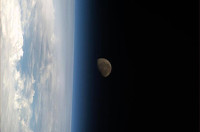 Yes, this is the moon rising
Yes, this is the moon rising
over the Earth's horizon. As much as
I needed to rotate the photo, I didn't.
This is the actual view
from the ISS... very different
from what we see on Earth. |
The International Space Station
478 words
An inspiring accomplishment
by Dianne Roth
Recently, I was asked what moves me, what touches my soul. It is not hard for me list the things that give me pleasure and evoke gratitude: family and friends are tops, the awe and wonder of the natural world always gives me goose bumps, and I am always astounded at the incredible accomplishments of the human mind, mixed with a bit of dismay at how contorted that mind can become.
One of the accomplishments that never fails to amaze me is the International Space Station (ISS).
I have been following the ISS for about two years. Many nights, if you drive by my house, you will find me standing in the dark gazing into the sky, ….waving.
My interest in the ISS began when a friend sent me a link to a YouTube tour by the former commander of the ISS, Sunita Williams. She made the video for kids, but I found it fascinating. I went to the NASA website to find out more and discovered if you give them your zip code and email address, they will send you information on sightings.
Back in the 50’s, we would search the night sky surrounding our campfires in hopes of spotting Sputnik, a Russian satellite. My mom had the eye and the determination. “There,” she would say and, amid the blanket of stars, one small dot would be moving across the sky. It was thrilling.
I was sure that spotting the ISS with the naked eye would be as challenging as finding Sputnik. To my surprise, I looked up when they told me to look up and there it was, racing across the night sky. I couldn’t help but wave. I was hooked.
The ISS is an international endeavor. It is home for six crew members who live and work in microgravity weightlessness. They conduct experiments that cannot be done in Earth’s 9.8 meters/second2 gravitational pull. (Ouch, that’s why it hurts when you fall.) On the ISS there is only 10% of the gravitational pull on Earth which allows everything and everyone to float nearly weightless.
Since launched in 2000, there have been 200 crew members from 15 nations. Mission 45 to replace the current crew was launched on September 2, 2015.
ISS travels 5 miles per second, orbiting the Earth every 90 minutes, 17 times every day. It’s orbiting pattern allows it, over time, to be visible by everyone on Earth except at the north and south poles. It has over an acre of solar panels to power the station.
It is the second brightest object in our night sky. The moon is first. On a clear night, you can watch it crossing the sky for up to six minutes.
To get notifications, search for “NASA ISS notifications”.
To see the ISS tour: www.youtube.com/watch?v=iY2b2APouQA
And remember, people are up there! Wave!
Dianne Roth is a teacher, mother, grandmother, and freelance
writer. She lives in Oregon.
|
|


